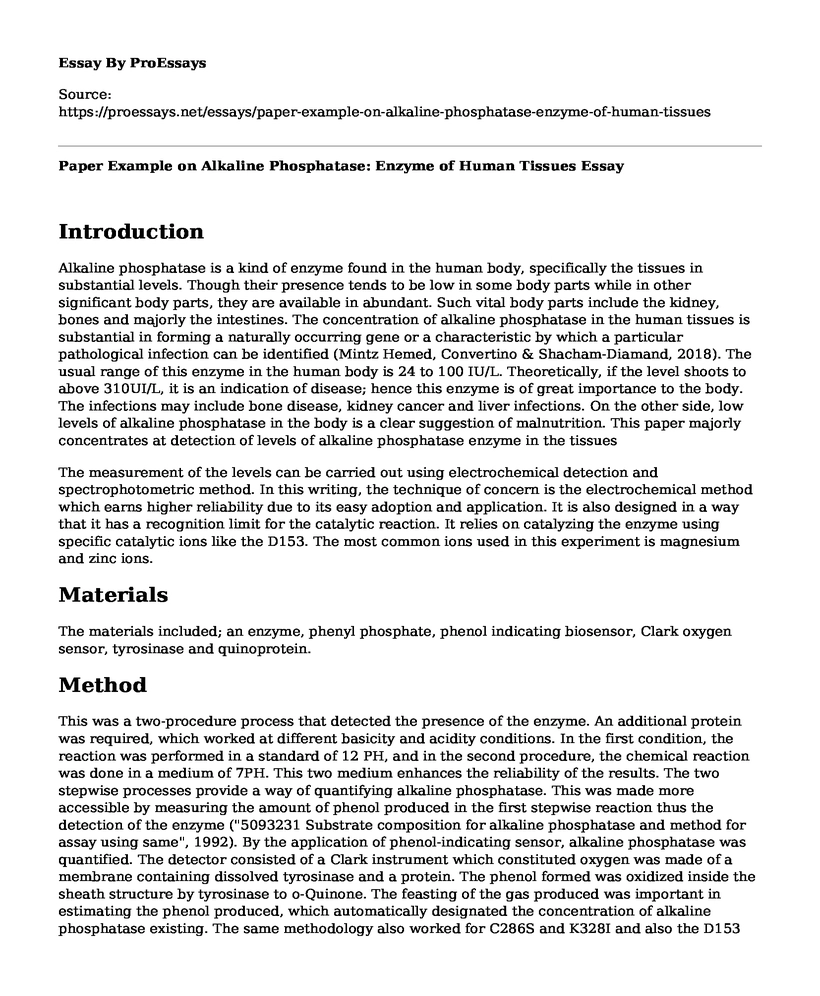Introduction
Alkaline phosphatase is a kind of enzyme found in the human body, specifically the tissues in substantial levels. Though their presence tends to be low in some body parts while in other significant body parts, they are available in abundant. Such vital body parts include the kidney, bones and majorly the intestines. The concentration of alkaline phosphatase in the human tissues is substantial in forming a naturally occurring gene or a characteristic by which a particular pathological infection can be identified (Mintz Hemed, Convertino & Shacham-Diamand, 2018). The usual range of this enzyme in the human body is 24 to 100 IU/L. Theoretically, if the level shoots to above 310UI/L, it is an indication of disease; hence this enzyme is of great importance to the body. The infections may include bone disease, kidney cancer and liver infections. On the other side, low levels of alkaline phosphatase in the body is a clear suggestion of malnutrition. This paper majorly concentrates at detection of levels of alkaline phosphatase enzyme in the tissues
The measurement of the levels can be carried out using electrochemical detection and spectrophotometric method. In this writing, the technique of concern is the electrochemical method which earns higher reliability due to its easy adoption and application. It is also designed in a way that it has a recognition limit for the catalytic reaction. It relies on catalyzing the enzyme using specific catalytic ions like the D153. The most common ions used in this experiment is magnesium and zinc ions.
Materials
The materials included; an enzyme, phenyl phosphate, phenol indicating biosensor, Clark oxygen sensor, tyrosinase and quinoprotein.
Method
This was a two-procedure process that detected the presence of the enzyme. An additional protein was required, which worked at different basicity and acidity conditions. In the first condition, the reaction was performed in a standard of 12 PH, and in the second procedure, the chemical reaction was done in a medium of 7PH. This two medium enhances the reliability of the results. The two stepwise processes provide a way of quantifying alkaline phosphatase. This was made more accessible by measuring the amount of phenol produced in the first stepwise reaction thus the detection of the enzyme ("5093231 Substrate composition for alkaline phosphatase and method for assay using same", 1992). By the application of phenol-indicating sensor, alkaline phosphatase was quantified. The detector consisted of a Clark instrument which constituted oxygen was made of a membrane containing dissolved tyrosinase and a protein. The phenol formed was oxidized inside the sheath structure by tyrosinase to o-Quinone. The feasting of the gas produced was important in estimating the phenol produced, which automatically designated the concentration of alkaline phosphatase existing. The same methodology also worked for C286S and K328I and also the D153 enzyme mutations.
This methodology was most proposed because of the feasibility of the chemical species used. The chemical enzymes used in the experiment do not have adverse effects on the users and also the vessels used during the reactions. They are well suited for the production of the phenol substance. Secondly, the biosensor used in the experiment is very capable of quantification since the phenol is very sensitive (Kulys, Jasaitis & Razumas, 1986). This is contributed by the fact that phenol can be easily oxidized. The biosensor only aids in the detection of the sensor output hence the estimation process. Any scientific experiment must be set up under particular temperatures for the accuracy of the results. The reasonable working temperature condition for most analyses is the standard room temperature. This experiment worked best under 32 to 37 degrees Celsius, which can be easily maintained during the test.
Conclusion
In conclusion, the electrochemical technique of detecting the presence of alkaline phosphatase is one of the accurate methods that produce reliable data in terms of quantity. Though when experimenting, caution has to be taken because some biological species affect the detection of the enzyme. Such species include ascorbic acid and glucose. This technique is more feasible since it can decompose phenyl phosphate.
References
Mintz Hemed, N., Convertino, A., & Shacham-Diamand, Y. (2018). Alkaline phosphatase detection using electrochemical impedance of anti-alkaline phosphatase antibody (Ab354) functionalized silicon-nanowire-forest in phosphate buffer solution. Sensors And Actuators B: Chemical, 259, 809-815. doi: 10.1016/j.snb.2017.12.136
5093231 Substrate composition for alkaline phosphatase and method for assay using same. (1992). Biotechnology Advances, 10(2), 301. doi: 10.1016/0734-9750(92)90119-t
Kulys, J., Jasaitis, J., & Razumas, V. (1986). Electrochemical regulation of immobilized alkaline phosphatase activity. Bioelectrochemistry And Bioenergetics, 16(2), 205-212. doi: 10.1016/0302-4598(86)85003-6
Cite this page
Paper Example on Alkaline Phosphatase: Enzyme of Human Tissues. (2023, Jul 12). Retrieved from https://proessays.net/essays/paper-example-on-alkaline-phosphatase-enzyme-of-human-tissues
If you are the original author of this essay and no longer wish to have it published on the ProEssays website, please click below to request its removal:
- Xarelto/Rivaroxaban
- Research Paper on Aspirin Synthesis and Characterization
- Essay Sample on Golly's Study Foundings
- The History of the Discovery of Dark Energy Essay Example
- Essay Example on Celestial Bodies: Their Motion and Gravity
- Article Analysis Essay on There May Be Flowing Water on Mars but Is There Intelligent Life on Earth?
- Essay Example on Linus Pauling: Nobel Laureate Who Changed Lives







